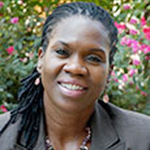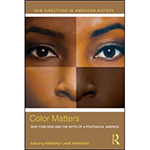
“One day, my youngest daughter came home from school and said that she ‘wished she had the cool skin,’” Norwood recalls. “When I asked what she meant by ‘the cool skin,’ she said, ‘More pink.’”
What her daughter was expressing was “colorism”—not racism that exists between blacks and whites, but something even more insidious, pervasive, and difficult to overcome: the preference, even among people of color, for lighter skin, Norwood recalls.
“Even my oldest daughter, who was then in high school, used to lament about the preference among African American males her age for fairer and lighter-skinned girls, especially those who also have long and flowing hair,” she says.
However, it wasn’t until she visited China that Norwood decided to dedicate herself to studying colorism.
“My first day in Shanghai, I noticed that on beautiful sunny days many people, particularly women, were walking around carrying umbrellas,” she says. “When I asked my Fudan University chaperones about this, one of them told me that the purpose of the umbrellas was to block the sun. After all, the student added, ‘Who wants to be dark?’”
As the two locked eyes with each other in the stunned silence that followed—Norwood has a chocolate colored skin tone—Norwood realized that she wanted to formally contribute to exposing the harm of colorism. From that moment on, her “antennae were even more sharply perked.” Throughout her time in China, she noticed that the working classes there appeared to have darker skin tones, while the more well-to-do people and professionals were lighter in skin tone. Virtually every image of females on television, on billboards, and in advertising portrayed Asian women with barely a hint of their Asianness. From the color of their skin to the shape of their noses, eyes, and lips, white beauty was on display.
“It astounded me! I was in a nation of people of color who rejected that distinction,” Norwood says. “Colorism is also huge in India. India and China together make up a third of the world’s population. Do you know what that means? That means at least a third of the world population is literally uncomfortable in their own skin. That reality overwhelmed me.” After encouragement from a colleague, Norwood decided to put together an anthology about colorism. She convinced 12 authors—including two research assistants, third-year law student Violeta Foreman and recent alumna Adrienne Johnson, JD ’13—to submit 9 essays on various aspects of colorism in local communities, in the United States, and throughout the world. Norwood wrote the introduction and two essays.
“Colorism is everywhere, even in food preferences,” she says. “Consider white rice, white bread, white potatoes, white meat in chicken. Even nuts! Take pistachios, for example. China is the world’s largest consumer of pistachios. There, the nuts are bleached to destroy the natural caramel colored shell in order to make them lighter and thus more appealing. As people interviewed about the two colors uniformly remarked, ‘Lighter is better,’” Norwood observes. “It’s a bias that you see everywhere, from Jamaica to the Philippines to Europe to the United States. White imagery is omnipresent and advanced as supreme. White represents power, success, desirability, and many people think, ‘I want that!’ Unfortunately, ‘that’ often translates not into wanting just what those people have (money, power, prestige, love), but rather actually wanting that lighter skin. The thinking is that lighter skin means a better life.”
Given that, how does Norwood explain the popularity of tanning beds in the United States?
“I have a few responses,” she says. “Tanning beds are not popular among brown or darker skinned people. The people most injured by colorism are not running to the tanning salons. In fact, many of those people are the ones who are bleaching their skin, at considerable risk to their health, to be lighter. Tans are temporary. Dabbling with darkness is sexy, exotic, fun. It’s a nice experiment. It isn’t one’s reality, though. Finally, we can’t forget that tanned white skin in this country currently is associated with wealth, and thus one’s status.” As Norwood establishes in the anthology, colonization has had a significant impact on colorism around the world. Indeed, “most formerly colonized countries took on the values and culture of the colonizer such that, even today, while independence reigns in many of these formerly colonized nations, the culture and values—including the symbiotic connection between white skin and power—remain firmly embedded within them.”
Colorism in the United States is especially complex, Norwood adds. In terms of African Americans, colorism in this country can be traced back more than 300 years. During slavery, sexual unions between slave women and white male slave owners produced “mulattos”—children, half black, half white—who were often lighter in skin tone.
Those children, while still slaves, often were preferred over their darker skinned counterparts. They were taught to read, taught skills, brought into the house to work, and often were able to sell their services, secure their own freedom, and eventually own their own property—including slaves of their own.
During Reconstruction, biracial and multiracial people were also often better equipped to transition to freedom. Ironically, their “privileged” status set them so apart from their darker skinned counterparts. Many went on to establish separate communities, neighborhoods, associations, and schools.
“The famous ‘paper bag’ tests, ‘blue vein’ societies, and ‘ruler’ tests were proof of the perpetuation of the value of light skin,” Norwood says. “And in many circles, circumstances, and situations today, this preference continues to be played out.”
 Norwood’s book demonstrates that colorism touches every corner of society, especially the law. “In the United States, darker skinned men and women are more likely to be arrested, convicted, and sentenced to death than their lighter skinned counterparts. Juries view (and therefore value the credibility of) people differently based on the color of the defendant’s skin, the witness’s skin, and the lawyer’s skin. Employment decisions, hirings, promotions, and demotions often can be traced to colorism,” she says.
Norwood’s book demonstrates that colorism touches every corner of society, especially the law. “In the United States, darker skinned men and women are more likely to be arrested, convicted, and sentenced to death than their lighter skinned counterparts. Juries view (and therefore value the credibility of) people differently based on the color of the defendant’s skin, the witness’s skin, and the lawyer’s skin. Employment decisions, hirings, promotions, and demotions often can be traced to colorism,” she says.
Colorism is even practiced by children. In the early 1950s, the plaintiffs in the Brown v. Board of Education case used the famous “doll study,” conducted by psychologists Kenneth and Mamie Clark, to help establish the detrimental effects of segregation on the attitude and esteem of young black children at the time. The children were asked to comment on two dolls, one black and one white. With stunning unanimity, black children associated positive feelings and connotations with the white doll, and negative connotations with the black doll.
In 2010, CNN hired renowned child psychologist Margaret Beale Spencer to create and perform a 21st century version of that famous study. This time, however, black and white children, including a preschooler, were used in the experiment. The 2010 results were virtually identical for children of both races. Some of the children’s parents were shocked to see not only their kids associating positive images and attributes to the white images, but also associating negative feelings toward the darker images.
“The parents said, ‘But we never talk about race at home. We teach them that we are all the same.’ And therein lies the problem,” Norwood says. “Not only does race matter, but color matters also. And even children as young as three know this to be true.
“Our task with the book is to bring colorism to the conscious level and to have open dialogue about it,” Norwood says. “We are not the first group of authors to raise this issue. Colorism is centuries years old. Yet, we find ourselves in this place where the practiced reality continues to be that lighter is better. It is an accepted and almost unquestioned norm. It is so engrained in our collective DNA that it thrives virtually undetected.
“I can’t tell you how many people tell me that this either isn’t a problem or doesn’t exist,” she continues. “Even many black, brown, and beige people, in the United States and throughout the world, make the same conclusions. In reality, though, societies are not colorblind. We live in a very colored world that is built upon a color caste system where dark people are relegated to life at the lowest levels of society. And the color caste is poised to become sharper, clearer, and more impenetrable. We hope to add our voices to the call toward the eradication of this growing form of discrimination.”
Vetta Sanders Thompson, PhD, associate professor of the Brown School, has researched this topic as well and contributes a chapter that moves the idea of colorism beyond skin color.
“Every marginalized ethnic group has issues with physical identification which includes the color of their skin,” Thompson says. “Physical features such as color and texture of hair, contours of the face and nose, body shape — all of these things relate to colorism. Skin color is almost never considered without some attention to these other physical features. The chapter I’ve written for the book suggests that while issues of race are reduced, they linger in other ways.
“I agree with Kim in that racial bias will continue to diminish, but colorism will not unless we focus on the issue,” Thompson says.
In addition to Thompson, other contributors to the book are: Taunya Banks, Kira Hudson Banks, Kevin D. Brown, Kellina Craig-Henderson, Paul Finkelman, Ronald Hall, Richard D. Harvey, Adrienne Johnson and Rachel E. Tennial.